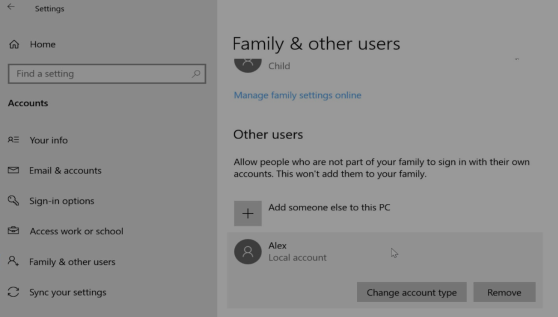If you're using Windows 10, version 1803 and later or Windows 11, you can add security questions as you'll see in step 4 under Create a local user account. With answers to your security questions, you can reset your Windows 10/11 local account password.
Windows 10
Step 1: Create a local user account
-
Select Start > Settings >Accounts and then select Family & other users.(In some versions of Windows you'll see Other users.)
-
Select Add someone else to this PC.
-
Select I don't have this person's sign-in information, and on the next page, select Add a user without a Microsoft account.
-
Enter a user name, password, or password hint—or choose security questions—and then select Next.
Step 2: Change a local user account to an administrator account
-
Select Start > Settings >Accounts.
-
Under Family & other users, select the account owner name (you should see "Local Account" below the name), then select Change account type.
Note: If you choose an account that shows an email address or doesn't say "Local account", then you're giving administrator permissions to a Microsoft account, not a local account.
-
Under Account type, select Administrator, and then select OK.
-
Sign in with the new administrator account.

Windows 11
Step 1: Create a local user account
-
Select Start > Settings >Accounts and then select Family & other users.(In some versions of Windows you'll see Other users.)
-
Next to Add other user, select Add account.
-
Select I don't have this person's sign-in information, and on the next page, select Add a user without a Microsoft account.
-
Enter a user name, password, or password hint—or choose security questions—and then select Next.
Step 2: Change a local user account to an administrator account
-
Select Start > Settings >Accounts.
-
Under Family & other users, select the account owner name (you should see "Local account" below the name), then select Change account type.
Note: If you choose an account that shows an email address or doesn't say "Local account", then you're giving administrator permissions to a Microsoft account, not a local account.
-
Under Account type, select Administrator, and then select OK.
-
Sign in with the new administrator account.

Comments
0 comments
Please sign in to leave a comment.